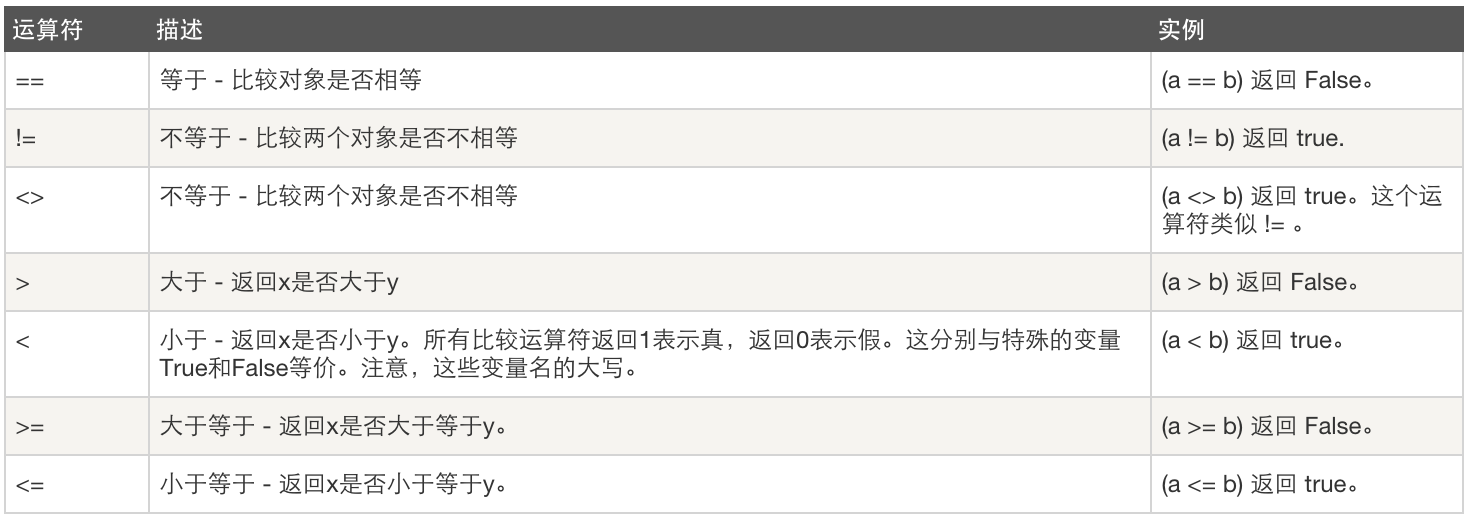一、介绍
python部分以python3为基础进行阐述,python强制缩进,不依赖于别的符号来划分区域,例如C语言的{ }。
print("Hello World!")
python C:UsersAdministratorDesktop est.py
执行python代码的步骤:
1.先启动python解释器
2.python解释器把文件内容从硬盘读入内存,不涉及程序的执行
3.读入内存后,再解释执行
执行python代码的两种方式
交互式
优点:即时调试程序,调试方法
缺点:无法永久保存代码
文件方式
优点:永久保存代码
缺点:不能即时调试代码
二、变量
python没有常量的概念,一切皆可以是变量,但习惯性的用全大写字母组成的字符代表常量,如AGE_OF_RAP = 56
变量是指可变化的量,可用来代指内存里某个地址中保存的内容。有如下规则:
1.变量名只能是字母、数字或下划线的任意组合
2.变量名的第一个字符不能是数字
3.以下关键字不能声明为变量名['and', 'as', 'assert', 'break', 'class', 'continue', 'def', 'del', 'elif', 'else', 'except', 'exec', 'finally', 'for', 'from', 'global', 'if', 'import', 'in', 'is', 'lambda', 'not', 'or', 'pass', 'print', 'raise', 'return', 'try', 'while', 'with', 'yield']
python中的变量名没有储存值的功能,只是一种绑定关系,当把x=10更改为x=11时,只是把x和10的
绑定关系解除掉,把x绑定到11这个值上。
>>>x=10 >>>id(x) 1581299040 >>>x=11 >>>id(x) 1581299072
两个id不同,说明是开辟了新的内存空间,那么现在10这个内存空间没有了任何绑定关系,python解释器会回收这个没有绑定名字的变量。
一个值绑定一个名字称为引用计数+1,什么是引用计数?x就是11这个值的引用,那么11这个值可不可以再来一个引用的名字?
>>>x 11 >>>y=x >>>id(y) 1581299072
和上面x的id一样,说明y这个名字也绑定到了11身上,现在11身上有两个名字绑定,那么11的引用计数为2,当引用计数为0的时候会被清理掉,那么什么时候会被清理掉呢?没有任何绑定的时候,如何才能没有绑定呢?
解除绑定关系的方式
x=100
y=200
这样一来,x与10的绑定,y与11的绑定都去掉了,10和11变为了没有任何绑定关系的内存空间了可以被清除掉了。
另一种解除绑定关系的方式
del x
这叫解除绑定,不叫删除
三、字符串
字符串,由单引号或双引号组成,如'i love python'或"i love python",具有不可变性,因此一旦建立便不能修改
>>>msg='I love python' >>>msg 'I love python' >>>msg.split() ['I','love','python']
字符串的拼接
>>>msg1='hello' >>>msg2='world' >>>msg3=msg1+msg2 'helloworld' >>>msg4=msg1*3 >>>msg4 'hellohellohello'
>>>print('hello'+' world') # + 少用
hello world
四、读取用户输入
python3弃用了raw_input(),只用input()进行读取用户的输入
username = input("What is your name?")
格式化输出
>>>name='tom' >>>print('my name is ',name) my name is tom >>> >>>name='tom' >>>age=18 >>>print('my name is %s, my age is %s' %(name,age)) my name is tom, my age is 18
五、列表
可以存放多个值,要取得列表内的元素,需要通过下标,从0开始
>>>list1 = ['physics', 'chemistry', 1997, 2000] >>>list2 = [1, 2, 3, 4, 5 ] >>>list3 = ["a", "b", "c", "d"]
>>>list4 = [1,'a',[2,3]]
>>>list4[0]
1
>>>list4[2][1]
3
六、字典
采用key:value方式存储值,可以存放多个值,每个值也可以是任意数据类型,但key必须是不可变数据类型
可变数据类型:列表,字典
id不变
type不变
值改变
不可变类型:value一旦改变,id也改变,如数字,字符串(id变,意味着创建了新的内存空间)
>>>d={'a':1}
>>>id(d)
31214184
>>>d['a']=2
>>>id(d)
31214184
>>>d
{'a':2}
#值改变,id不变
>>>num=10 >>>id(num) 1349825888 >>>num=11111 >>>id(num) 5743728 >>> >>>s='abc' >>>id(s) 31149280 >>>s='def' >>>id(s) 32025656 #值改变,id也变
>>>dict1 = { 'abc': '456' }
>>>dict2 = { 'abc': 123,'98.6':'37' }
>>>dic2['abc']
123
>>>dic2['count'] = 2
>>>dic
{'abc': 123,'98.6':'37','count':2}
三种成员设计形式
>>>users=[['tom','123'],['jerry':'123']] >>>users[0] ['tom','123'] >>>users[0][1] '123' >>> >>>users=[{'tom':'123'},{'jerry':'123'}] >>>users[1]{'tom'} '123' >>> >>>users={'tom':'123','jerry':'123'} >>>users['tom'] '123' >>>'jerry' in users True >>>
七、流程控制
x = int(input("请输入您的总分:")) if x >= 90: print('优') elif x>=80: print('良') elif x >= 70: print('中') elif x >= 60: print('合格') else: print('不合格')
八、循环
#!/usr/bin/python count = 0 while count < 9: print 'The count is:', count count = count + 1 print "Good bye!"
age=50 count=1 while count <=3: age_input=int(input('input age: ')) if age_input > age: print('too big') count +=1 elif age_input < age: print('too small') count +=1 else: print('got it') break
count = 0
while count <= 10:
if count % 2 != 0:
count+=1
continue
print(count)
while True: cmd = input('>>:') if cmd == 'q': break
count=0 while True: if conut > 2: print('too many tries') break user=input('user: ') password=input('password: ') if user == 'tom' and password == '123': print('Login successful') while True: cmd=input('>>: ') if cmd == 'q': break print('exec %s' % cmd) break else: print('Login error') count+=1
count=0 tag=True while tag: if conut > 2: print('too many tries') break user=input('user: ') password=input('password: ') if user == 'tom' and password == '123': print('Login successful') while tag: cmd=input('>>: ') if cmd == 'q': tag=False continue print('exec %s' % cmd) else: print('Login error') count+=1
count=1 while count <= 5: print(count) count+=1 else: #while没有被break打断的时候才执行else的子代码 print('====')
九、运算符
算术运算
比较运算

逻辑运算

